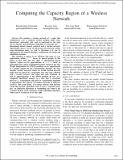Computing the Capacity Region of a Wireless Network
Author(s)
Gummadi, Ramakrishna; Jung, Kyomin; Shah, Devavrat; Sreenivas, Ramavarapu
DownloadShah_Computing the.pdf (236.1Kb)
PUBLISHER_POLICY
Publisher Policy
Article is made available in accordance with the publisher's policy and may be subject to US copyright law. Please refer to the publisher's site for terms of use.
Terms of use
Metadata
Show full item recordAbstract
We consider a wireless network of n nodes that communicate over a common wireless medium under some interference constraints. Our work is motivated by the need for an efficient and distributed algorithm to determine the n2 dimensional unicast capacity region of such a wireless network. Equivalently, given a vector of end-to-end rates between various source-destination pairs, we seek to determine if it can be supported by the network through a combination of routing and scheduling decisions. This question is known to be NP-hard and hard to even approximate within n1-o(1)[superscript 1-o1] factor for general graphs. In this paper, we first show that the whole n2 [superscript 2] dimensional unicast capacity region can be approximated to (1 plusmn epsiv) factor in polynomial time, and in a distributed manner, whenever the Max Weight Independent Set (MWIS) problem can be approximated in a similar fashion for the corresponding topology. We then consider wireless networks which are usually formed between nodes that are placed in a geographic area and come endowed with a certain geometry, and argue that such situations do lead to approximations to the MWIS problem (in fact, in a completely distributed manner, in a time that is essentially linear in n). Consequently, this gives us a polynomial algorithm to approximate the capacity of wireless networks to arbitrary accuracy. This result hence, is in sharp contrast with previous works that provide algorithms with at least a constant factor loss. An important ingredient in establishing our result is the transient analysis of the maximum weight scheduling algorithm, which can be of interest in its own right.
Date issued
2009-04Department
Massachusetts Institute of Technology. Department of Electrical Engineering and Computer Science; Massachusetts Institute of Technology. Laboratory for Information and Decision SystemsJournal
IEEE INFOCOM
Publisher
Institute of Electrical and Electronics Engineers
Citation
Shah, D., and R. Sreenivas, with Gummadi, R., Kyomin Jung. “Computing the Capacity Region Of a Wireless Network.” Infocom 2009, Ieee. 2009. 1341-1349. Copyright © 2009, IEEE
Version: Final published version
Other identifiers
INSPEC Accession Number: 10685543
ISBN
978-1-4244-3512-8
ISSN
0743-166X